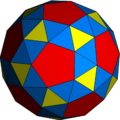 Snub cube or Snub cuboctahedron |
 Snub dodecahedron or Snub icosidodecahedron |


In geometry, a snub is an operation applied to a polyhedron. The term originates from Kepler's names of two Archimedean solids, for the snub cube (cubus simus) and snub dodecahedron (dodecaedron simum).[1]
In general, snubs have chiral symmetry with two forms: with clockwise or counterclockwise orientation. By Kepler's names, a snub can be seen as an expansion of a regular polyhedron: moving the faces apart, twisting them about their centers, adding new polygons centered on the original vertices, and adding pairs of triangles fitting between the original edges.
The terminology was generalized by Coxeter, with a slightly different definition, for a wider set of uniform polytopes.
